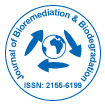Advancements in Bioremediation of Emerging Contaminants: Innovative Approaches for Enhancing Environmental Sustainability
*Corresponding Author: Xiamen Lion, College of Sericulture, Textile and Biomass Sciences, Southwest University, China, Email: lionxiamen22@gmail.comReceived Date: Jan 01, 2025 / Published Date: Jan 30, 2025
Citation: Xiamen L (2025) Advancements in Bioremediation of EmergingContaminants: Innovative Approaches for Enhancing Environmental Sustainability.J Bioremediat Biodegrad, 16: 660.
Copyright: © 2025 Xiamen L. This is an open-access article distributed under theterms of the Creative Commons Attribution License, which permits unrestricteduse, distribution, and reproduction in any medium, provided the original author andsource are credited.
Abstract
The growing presence of emerging contaminants, including pharmaceuticals, personal care products, industrial B i o chemicals, and microplastics, poses significant risks to environmental health and sustainability. Conventional methods for removing these pollutants often fall short due to their complexity, underscoring the need for more innovative and effective solutions. Bioremediation, which utilizes the natural ability of microorganisms and plants to degrade or transform contaminants, has emerged as a promising strategy. This review examines recent advancements in bioremediation technologies designed to address these emerging pollutants, with a focus on innovative microbial consortia, genetically engineered organisms, and advanced biotechnological applications. Furthermore, the paper explores the synergy between bioremediation and other environmental sustainability frameworks, such as circular economy principles and resource recovery. By improving the efficiency and specificity of biodegradation processes, these cutting-edge approaches play a crucial role in achieving a more sustainable and healthier environment.

 Spanish
Spanish  Chinese
Chinese  Russian
Russian  German
German  French
French  Japanese
Japanese  Portuguese
Portuguese  Hindi
Hindi 
